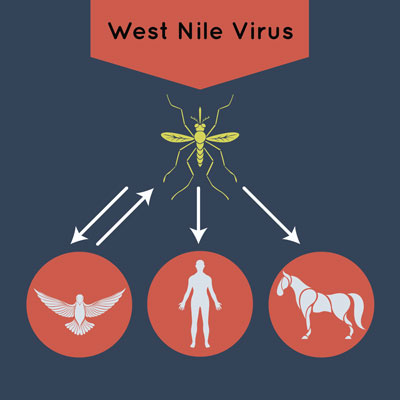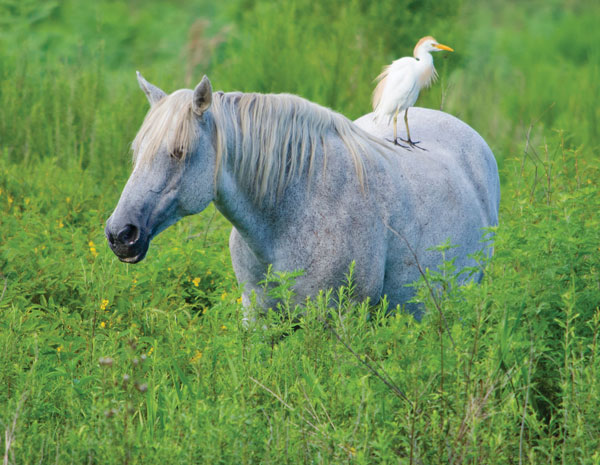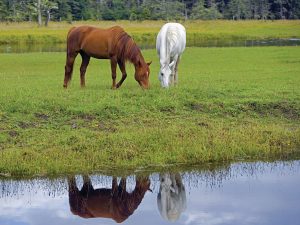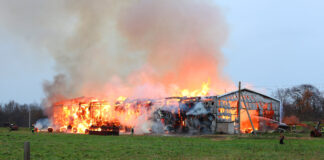
It may seem as if West Nile virus has always been a threat to horses. However, it only arrived on the Northeastern shores of the United States just two decades ago in 1999. Within a short three-year period, the virus was found across the country in 15,000 horses in 41 states. You might be asking, “How did it spread so quickly?” We’ll take a look at what West Nile virus is and how it affects your horse, the risks and how it is transmitted, plus specific preventive measures you can you take to protect your horse.

West Nile Virus Symptoms to Watch For
How this manifests depends on which areas of the central nervous system are affected. Common symptoms vary both in location and severity. Some horses become ataxic (uncoordinated) in the hind limbs. The horse stumbles, drags its toes, and may lilt to one side more than the other. There is often muscle twitching or tremors in the face, muzzle and lips, and/or in the neck, shoulders and chest. The horse may have trouble swallowing or experience impaired vision.
Normally tractable and calm horses might become hypersensitive to touch and/or sound. Fever and depression are common symptoms, along with limb weakness. In severe cases, the horse may wander aimlessly, develop convulsions, or become paralyzed in the rear quarters and go down on the ground, unable to rise. Death occurs in 30 to 40 percent of cases. Of those that survive, as many as 40 percent of cases persist with neurologic gait and behavior symptoms for six months, and some deficits may persist indefinitely.
Other mosquito-borne viruses, such as Eastern or Western encephalomyelitis (EEE and WEE), have similar clinical signs to West Nile virus. Blood testing provides a definitive diagnosis.
Since WNV was first seen in the United States, many companies have worked to create an effective vaccine to protect against the disease.
Going Viral
Transmission of WNV relies on interplay between birds and mosquitoes, particularly Culex species mosquitoes. Birds are the reservoir for the virus, and many (like crows, ravens, jays, house finches, owls and hawks) often succumb to the infection.
If a mosquito bites an infected bird, it can carry the virus to horse or human (and to other birds) when it takes its next blood meal.
If you see dead birds on your property, notify your public health official and have them tested for WNV. If you have chickens on your property, move them to a location far away from the horses. Only a small amount of virus circulates in horse or human blood following a bite from an infected mosquito. This is good news because this small amount of blood-borne virus is not transmissible between horse and horse, human and human, or horse and human. Horses and humans are considered “dead-end” hosts.
Another welcome piece of good news is that not every horse or every human exposed to the virus actually develops the disease.
The Risks for West Nile Virus
All horses are at risk of contracting WNV if the right precautions aren’t taken. Other notable factors include:
◆ Horses that have not received a full series of WNV immunizations or have had inadequate number of vaccine boosters are at high risk of contracting the disease.
◆ Horses older than 15 are more at risk of developing severe neurological signs and dying as a consequence of the infection.
◆ Horses developing signs later in mosquito season (weeks 36-38) have less favorable odds of survival than horses infected with WNV clinical signs earlier (weeks 31-33).
In temperate climates, West Nile virus tends to appear in the mid to late summer months, lasting until a good killing frost that eliminates mosquitoes.
The American Association of Equine Practitioners (AAEP) considers WNV vaccine to be a core vaccine that should be given to all horses at least once a year.
Immunization
Since WNV was first seen in the United States, many companies have worked to create an effective vaccine to protect against the disease. To date, there are four or five different commercial vaccines against WNV for horses, yet none for humans.
The American Association of Equine Practitioners (AAEP) considers the WNV vaccine to be a core vaccine that should be given to all horses at least once a year. Immunization coverage is simple, with a two-dose series for adult horses. The horse is given the initial vaccine and then boosted with a second dose four to six weeks later, with the timing dependent on the type of WNV vaccine used. This is then boosted annually before mosquitoes start to hatch.
In some parts of the country where mosquitoes are abundant year-round, it may be necessary to boost the vaccine twice a year.
Foals need to be vaccinated with a three-dose series with timing that depends on the vaccination status of the mare; ask your vet for more information if you own a foal.

Property Management
Anything that can hold standing water is considered a mosquito breeding ground: gutters, flowerpots, buckets, swimming pool covers, wading pools, discarded tires, wheelbarrows, bird baths, and tractor buckets, to name a few.
DRAINAGE: Even a hoof print in mud or near a water tank is able to hold sufficient water for mosquito larvae to hatch. Turn water containers over and drill holes in the bottom to facilitate drainage when appropriate. Establish good drainage around the barn, stalls and runs. Apply gravel to areas driven over by cars and farm implements to eliminate mud and tire tracks that can hold water.

STANDING WATER: Clean stock tanks regularly to remove debris and make them less attractive to breeding mosquitoes. Ditches, creeks and ponds are also mosquito habitats; ponds can be managed with aeration systems and with larvae-eating fish.
KILL THE LIGHTS: Eliminate incandescent bulb lights around the barn and paddocks, as these are mosquito attractants. These lights placed elsewhere on the property lure mosquitoes away from horse proximity. Bug “zapper” devices kill roaming mosquitoes.
CREATE PHYSICAL BARRIERS: This is accomplished by using fl y masks, fly sheets, fly boots, and insect repellent. Permethrin-containing repellents are useful but may need frequent application.
MISTING SYSTEMS: Barns can be misted regularly with chemical insecticides. Take care to spray into cracks and corners of the barn where mosquitoes often lurk.
FANS: During active mosquito hours (dawn and dusk), it helps to aim a fan at a stalled horse to create a sufficient breeze that mosquitoes can’t negotiate. Screens on the windows and stall doors also limit mosquito access.
Attention to management details, along with immunization, is the most reliable way of protecting your horse against WNV infection.
This article on West Nile virus originally appeared in the August 2019 issue of Horse Illustrated magazine. Click here to subscribe!





